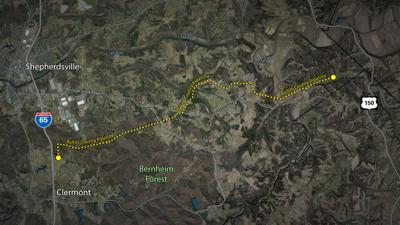Source: WDRB
By Marcus Green
May 30, 2019
To view video associated with this story, click here.

The firm, EnSite USA, reviewed 10 corridors for the new line and ranked them based on cost and impact on streams, land use, threatened and endangered species and other factors.
But instead of those routes, or any others EnSite analyzed, LG&E decided to start its line farther north near Mount Washington and send it southwest, traveling south of the Salt River before crossing rugged land that was later purchased by Bernheim Arboretum and Research Forest.

It’s that route that has alarmed Bernheim officials, who have raised concerns over a pipeline disrupting landbeing developed into a wildlife corridor. The forest organization’s board of trustees voted unanimously earlier this year to oppose the pipeline and refuse to sell an easement for its construction.
Meanwhile, some Bullitt County residents with property in the pipeline’s path have questioned a regulatory process that let LG&E keep the route secret until after it had received approval from Kentucky’s Public Service Commission and begun buying land.
A group of neighbors called Friends of Cedar Grove has been vocal in its opposition to a project that would affect their land. Another organization, SouthEast Bullitt Community Inc., also disagrees with a route that crosses the Bernheim property, chairman William Kidd said.
In the 2015 study, EnSite weighed pipeline routes well to the south, including some that crossed through Nelson and Hardin counties. But none of those routes were considered; instead, LG&E moved forward with a new path that was solely within Bullitt County when it applied for the project to the Public Service Commission in 2016.
Among the most noticeable changes to the top routes scored by EnSite is the ending point. Instead of a line that stops at the Beam distillery in Clermont, LG&E now plans to end its pipeline farther north – on the east side of Interstate 65 across from a rest area.
The utility made the change after getting “additional information from local officials and other sources,” Lonnie E. Bellar, an LG&E executive, told state regulators in early 2017.
Bellar, who now serves as LG&E’s chief operating officer, explained that the new starting point made the pipeline shorter and followed an existing electrical line corridor for a “considerable portion” of the route.
He also said the new route came about after receiving “information from a large customer about projections for increased gas usage.” LG&E has declined to identify that customer. But utility spokeswoman Natasha Collins said the specific amount of the increase wasn’t known until after the 2015 study.
LG&E took into account data on where home construction, warehouses and industrial developments were anticipated, Collins said in an email. It also factored in a new I-65 exit that’s now under construction.
“This information was used to determine where additional gas supply and capacity was needed, not to determine the overall route location,” she said.
LG&E expects the 12-mile pipeline will cost $39 million and take six to nine months once construction begins. The utility has acquired at least 85 percent of the easements it needs.
Snider, the economic development official, said his agency gave LG&E a map showing where development was planned in 2016, but he wasn’t aware of the exact route until several months ago.
“We did not have anything to do with the location of the pipeline,” he said. “It’s pure and simple. We didn’t have anything to do with that.”
Snider said he has sympathy with Bullitt County residents whose land is slated for the pipeline and don’t want it. And he agrees that the entire project could have been more transparent.
But he argues a new pipeline is needed. As the county grows, Snider said, the existing gas transmission system is running out of capacity to serve new customers.
“We’ve refused some companies lately that were heavy gas users because we knew we didn’t have the gas and we weren’t sure when we were going to get it,” he said.
Reach reporter Marcus Green at 502-585-0825, mgreen@wdrb.com, on Twitter or on Facebook. Copyright 2019 WDRB Media. All rights reserved.

